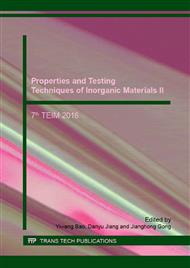[1]
T. Maruyama, S. Onose, T. Kaito, H. Horiuchi, Effect of fast neutron irradiation on the properties of boron carbide pellet, J. Nucl. Sci. Technol. 34 (1997) 1006-1014.
DOI: 10.1080/18811248.1997.9733777
Google Scholar
[2]
T. Inoue, T. Onchi, H. Kôyama, H. Suzuki, Irradiation effects of boron carbide used as control rod elements in fast breeder reactors, J. Nucl. Mater. 74 (1978) 114-122.
DOI: 10.1016/0022-3115(78)90539-1
Google Scholar
[3]
G.W. Hollenberg, J.A. Basmajian, Crack propagation in irradiated B4C induced by swelling and thermal gradients. J. Am. Ceram. Soc. 65 (1982) 179-181.
DOI: 10.1111/j.1151-2916.1982.tb10398.x
Google Scholar
[4]
T. Stoto, N. Housseau, L. Zuppiroli, B. Kryger, Swelling and microcracking of boron carbide subjected to fast neutron irradiations, J. Appl. Phys. 68 (1990) 3198-3206.
DOI: 10.1063/1.346370
Google Scholar
[5]
Y. Morohashi, T. Maruyama, T. Donomae, Y. Tachi, S. Onose, Neutron irradiation effect on isotopically tailored 11B4C, J. Nucl. Sci. Technol. 45 (2008) 867-872.
DOI: 10.1080/18811248.2008.9711488
Google Scholar
[6]
G.W. Hollenberg, J.L. Jackson, J.A. Basmajian, In-reactor measurement of neutron absorber performance, Nucl. Technol. 49 (1980) 92-101.
DOI: 10.13182/nt80-a32510
Google Scholar
[7]
M. Bouchacourt, F. Thevenot. The correlation between the thermoelectri properties and stoichiometry in the boron carbide phase B4C-B10. 5C, J. Mater. Sci. 20 (1985) 1237-1247.
DOI: 10.1007/bf01026319
Google Scholar
[8]
J. Wu, N.P. Padture, P.G. Klemens, M. Gell, E. Garcia, P. Miranzo, M. I. Osendi, Thermal conductivity of ceramics in the ZrO2-GdO1. 5 system, J. Mater. Res. 17 (2002) 3193-3200.
DOI: 10.1557/jmr.2002.0462
Google Scholar
[9]
M. C. Roufosse, P. G. Klemens, Lattice thermal conductivity of minerals at high temperatures, J. Geophys. Res. 79 (1974) 703-705.
DOI: 10.1029/jb079i005p00703
Google Scholar
[10]
P. G. Klemens, Thermal resistance due to point defects at high temperatures, Phys. Rev. 119 (1960) 507-509.
DOI: 10.1103/physrev.119.507
Google Scholar
[11]
C.L. Wan, W. Pan, Q. Xu, Y.X. Qin, JD. Wang, Z. X. Qu, M.H. Fang, Effect of point defects on the thermal transport properties of (LaxGd1-x)2Zr2O7: Experiment and theoretical model, Phys. Rev. B 74 (2006) 144109.
Google Scholar


